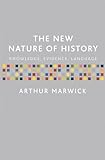The new nature of history: knowledge, evidence, language / Arthur Marwick
Material type: TextPublication details: Houndmills, Basingstoke, Hampshire: Palgrave, 2001Description: xvi, 334 p.; 24 cmISBN: 0333964470; 033392262X (pbk.)Subject(s): History -- Philosophy | History -- MethodologyDDC classification: 930
TextPublication details: Houndmills, Basingstoke, Hampshire: Palgrave, 2001Description: xvi, 334 p.; 24 cmISBN: 0333964470; 033392262X (pbk.)Subject(s): History -- Philosophy | History -- MethodologyDDC classification: 930 | Item type | Current library | Call number | Status | Date due | Barcode | Item holds |
|---|---|---|---|---|---|---|
|
|
Central Library, Sikkim University General Book Section | 930 MAR/N (Browse shelf(Opens below)) | Available | P32804 |
Includes bibliographical references and index.
Preface
1 Introduction: The Battle of Basic Assumptions
1 Stating my Position
2 Eight Battlegrounds
Metaphysical, Nomothetic and Ontological Approaches
Radical Politics - or just Nihilism?
The Nature of Societies; Past, Present and Future
The Cultural Construction of Knowledge - and Everything Else
Language: History a Branch of Literature? Textuality - the Alleged Existence Thereof Disagreements Among Historians What Precisely is the Danger?
2 History: Essential Knowledge about the Past
1 The Past, History, and Sources
The Past
Primary and Secondary Sources Defining ’History’ and ’Historiography’
2 The Necessity for History
History: A Social Necessity Other Justifications for History
3 The auteur Theory of History and the Question of
Subjectivity
The Historian as auteur
Relativism: R. G. Collingwood
The Subjectivity Question
3 How the Discipline of History Evolved: From Thucydides to Langlois and Seignobos
1 From Ancient Athens to the Enlightenment The Exemplar History of the Ancients
The Medieval Chronicles
Renaissance Histories and Ancillary Techniques
The Enlightenment
2 Ranke: His Disciples and his Critics
Vico and Herder Ranke and Niebuhr Mommsen and Burckhardt
Thierry, Michelet and de Tocqueville
3 Positivism and Marxism Comte
Marx
Fustel de Coulanges
4 Anglo-Saxon Attitudes
Macaulay and the Whig Historians
Bishop Stubbs
From Freeman to Tout and Acton The United States
5 The End of the Century
Five Major Issues
Scientific History? Langlois and Seignobos
History as Literature
4 How the Discipline of History Evolved: Through the
Twentieth into the Twenty-First Century
1 ’New’ History
The Three ’New Histories’
American ’New History’
Founders of the Annales School; Febvre and Bloch
Pirerme, Labrousse, Lefebvre
Bloch’s The Historian’s Craft
2 The Rise of the Sub-Histories
Meinecke, Chabod and Ritter
Early Labour and Economic Histories in Britain
Mcllwain, Namier and Elton
3 Latter-day Marxism and Past and Present
British Marxist Historiographers: Tosh and Carr
The Frankfurt School and Structuralism:
TTie Cross-Fertilisation of Marxism
’Western Marxism’ and the Study of the French Revolution
The British Marxists The American Marxists
Jurgen Kocka
4 Annales: The Second and Third Generations
Braudel
Annales: The Third Generation
5 New Economic History, New Social History, History of
Science, New Cultural History New Economic History
Historical Demography, Urban History, History of the Family, of Childhood and of Death Feminist History: History of Women The History of Science, Medicine and Technology
New Social History
The ’HistorikerstreW
New Cultural History
Natalie Zemon Davis
The Cambridge Connection
Microhistory: Menocchio the Miller
Chartier
6 The Start of a New Century: Nothing Ruled Out
5 The Historian at Work: Forget ’Facts’, Foreground Sources
1 ’Facts’
2 Primary and Secondary Sources Vive la difference!
The Hierarchy of Primary Sources; Bibliographies
Relationship Between-Primary and Secondary Sources:
Footnotes
Integrating Primary and Secondary Sources: Strategy
3 The Immense Variety of Primary Sources Strengths and Weaknesses of Different Types of Primary
Sources
A Taxonomy of Primary Sources
4 Witting and Unwitting Testimony
5 A Catechism for the Analysis, Evaluation and Use of
Primary Sources
The Catechism
Practising on One Example
6 The Arts as Sources Use and Abuse of the Arts Art as a Source
6 The Historian at Work: The Communication of Historical
Knowledge
1 The Ftmdamentals of Good Writing
Different Levels of Communication and the Basic Skill of
Writing
Writing a Paragraph
Writing a Thesis or Book
2 Explanation, Periodisation, and Structure
Analysis
Causes and Outcomes: The Elton Model
Hierarchy of Explanatory Factors
Structure
Two Examples of Structures
3 Comparative History
4 Concepts and Cliches
Cliches
Concepts
’Gender’, ’Patriarchy’, ’Moral Panics’, and so on
’Culture’ and ’Cultural’
’Class’ and ’State’
Revisionism
5 Quotations and Scholarly Apparatus
Use of Quotation
Identifying Quotations: Footnotes Bibliographies
6 Types of Historical Communication: From Scholarly
Monograph to Museums, Films and Television
Levels of Historical Communication: ’Public History’
The PhD Thesis or Dissertation
Monographs and Learned Articles
The Scholarly Synthesis
Textbooks
Pop History
Some Examples of Public History
Television History
Feature Films
7 Theory, the Sciences, the Humanities
1 History, Theory, the Sciences
Sokal and Bricmont
The Nature of Scientific Theory
History and the Sciences
History as an Autonomous Discipline
Postmodernist Metaphysics
Foucault
Compromising with Postmodernism
2 History, Sociobiology, Social Sciences and Humanities
Evolutionary Psychology
Economics, Political Science, Social Psychology
History’s Place in the University
8 Conclusion: Crisis, What Crisis?
Appendix A: An Example of Learning Outcomes for a
History Degree
1 Knowledge and Understanding
2 Key Skills
3 Cognitive Skills
4 Professional and Practical Skills
Appendix B: Examples of Aims and Objectives
1 Aims of the Open University Course Total War and Social
Change: Europe 1914r-1955
2 Objectives for Unit 13, ’Challenges to Central Government,
1660s to 1714’, from the Open University Course Princes
and Peoples: The British Isles and France c. 1630-1714
Appendix C: Writing History
1 Planning a History Essay
2 Guidance on Writing an Essay
3 A Brief Guide to Referencing for Historians (by Armika
Mombauer)


There are no comments on this title.